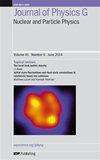使用机器学习方法估计即使是超重核的离子势垒高度
IF 3.4
3区 物理与天体物理
Q2 PHYSICS, NUCLEAR
Journal of Physics G: Nuclear and Particle Physics
Pub Date : 2023-02-09
DOI:10.1088/1361-6471/acbaaf
引用次数: 2
摘要
利用裂变势垒高度信息,也可以得出超重核的生存概率。因此,准确了解裂变势垒是很重要的,例如在超重核区的稳定岛上发现超重核。本研究采用立体主义模型、随机森林、支持向量回归、极端梯度增强和人工神经网络五种机器学习技术,准确预测了质子数在92至120之间的140≤N≤216区域330个甚至超重核的裂变势垒。将所得结果与其他理论模型计算估计值和实验结果进行了比较。根据所得结果,得出结论:立体主义模型、支持向量回归和极端梯度助推方法通常能给出更好的结果,是估计裂变势垒高度的更好工具。本文章由计算机程序翻译,如有差异,请以英文原文为准。
Estimation of fission barrier heights for even-even superheavy nuclei using machine learning approaches
With the fission barrier height information, the survival probabilities of super-heavy nuclei can also be reached. Therefore, it is important to have accurate knowledge of fission barriers, for example, the discovery of super-heavy nuclei in the stability island in the super-heavy nuclei region. In this study, five machine learning techniques, cubist model, random forest, support vector regression, extreme gradient boosting and artificial neural network were used to accurately predict the fission barriers of 330 even-even super-heavy nuclei in the region 140 ≤ N ≤ 216 with proton numbers between 92 and 120. The obtained results were compared both among themselves and with other theoretical model calculation estimates and experimental results. According to the results obtained, it was concluded that the cubist model, support vector regression and extreme gradient boosting methods generally gave better results and could be a better tool for estimating fission barrier heights.
求助全文
通过发布文献求助,成功后即可免费获取论文全文。
去求助
来源期刊
CiteScore
7.60
自引率
5.70%
发文量
105
审稿时长
1 months
期刊介绍:
Journal of Physics G: Nuclear and Particle Physics (JPhysG) publishes articles on theoretical and experimental topics in all areas of nuclear and particle physics, including nuclear and particle astrophysics. The journal welcomes submissions from any interface area between these fields.
All aspects of fundamental nuclear physics research, including:
nuclear forces and few-body systems;
nuclear structure and nuclear reactions;
rare decays and fundamental symmetries;
hadronic physics, lattice QCD;
heavy-ion physics;
hot and dense matter, QCD phase diagram.
All aspects of elementary particle physics research, including:
high-energy particle physics;
neutrino physics;
phenomenology and theory;
beyond standard model physics;
electroweak interactions;
fundamental symmetries.
All aspects of nuclear and particle astrophysics including:
nuclear physics of stars and stellar explosions;
nucleosynthesis;
nuclear equation of state;
astrophysical neutrino physics;
cosmic rays;
dark matter.
JPhysG publishes a variety of article types for the community. As well as high-quality research papers, this includes our prestigious topical review series, focus issues, and the rapid publication of letters.

 求助内容:
求助内容: 应助结果提醒方式:
应助结果提醒方式:


